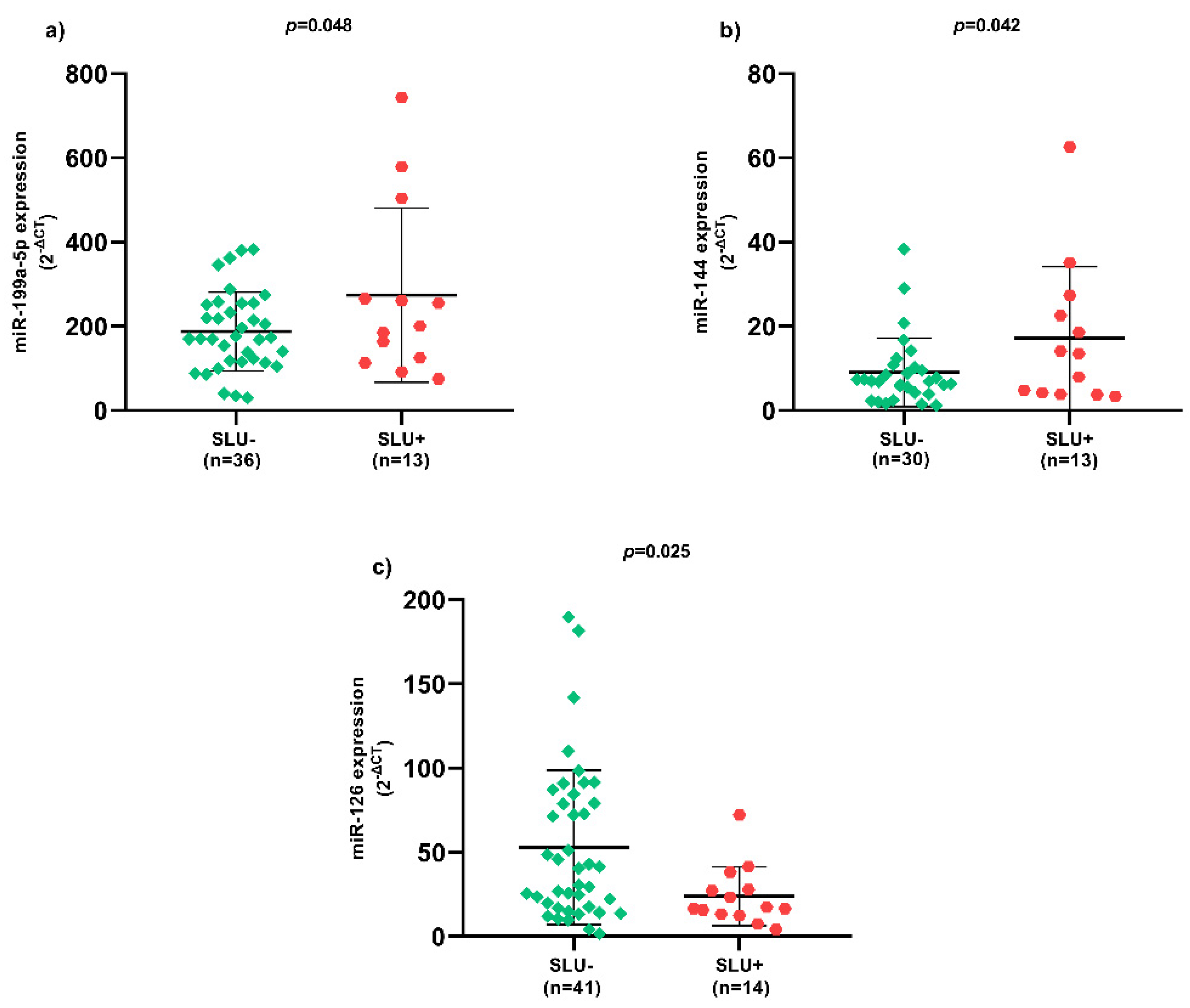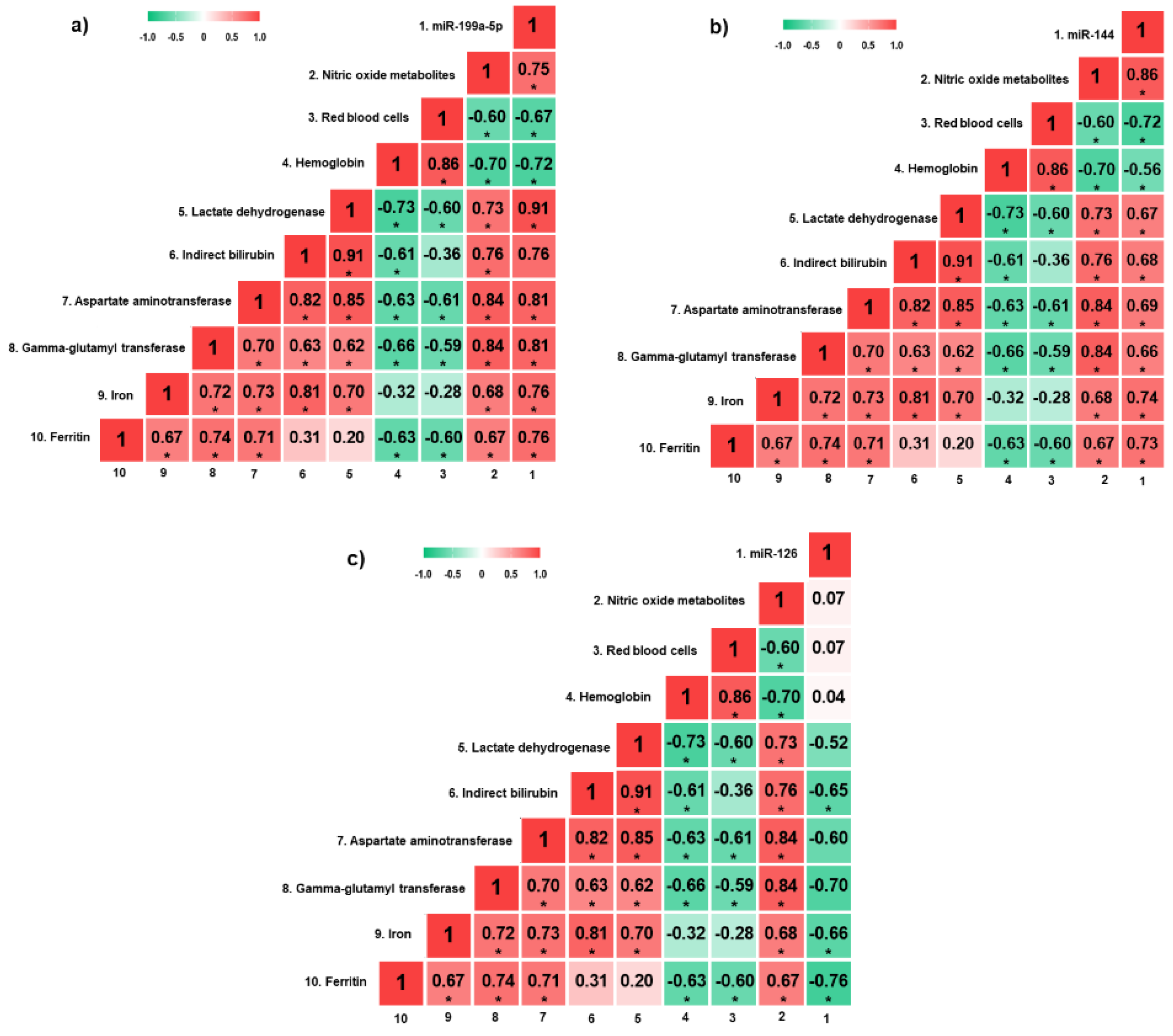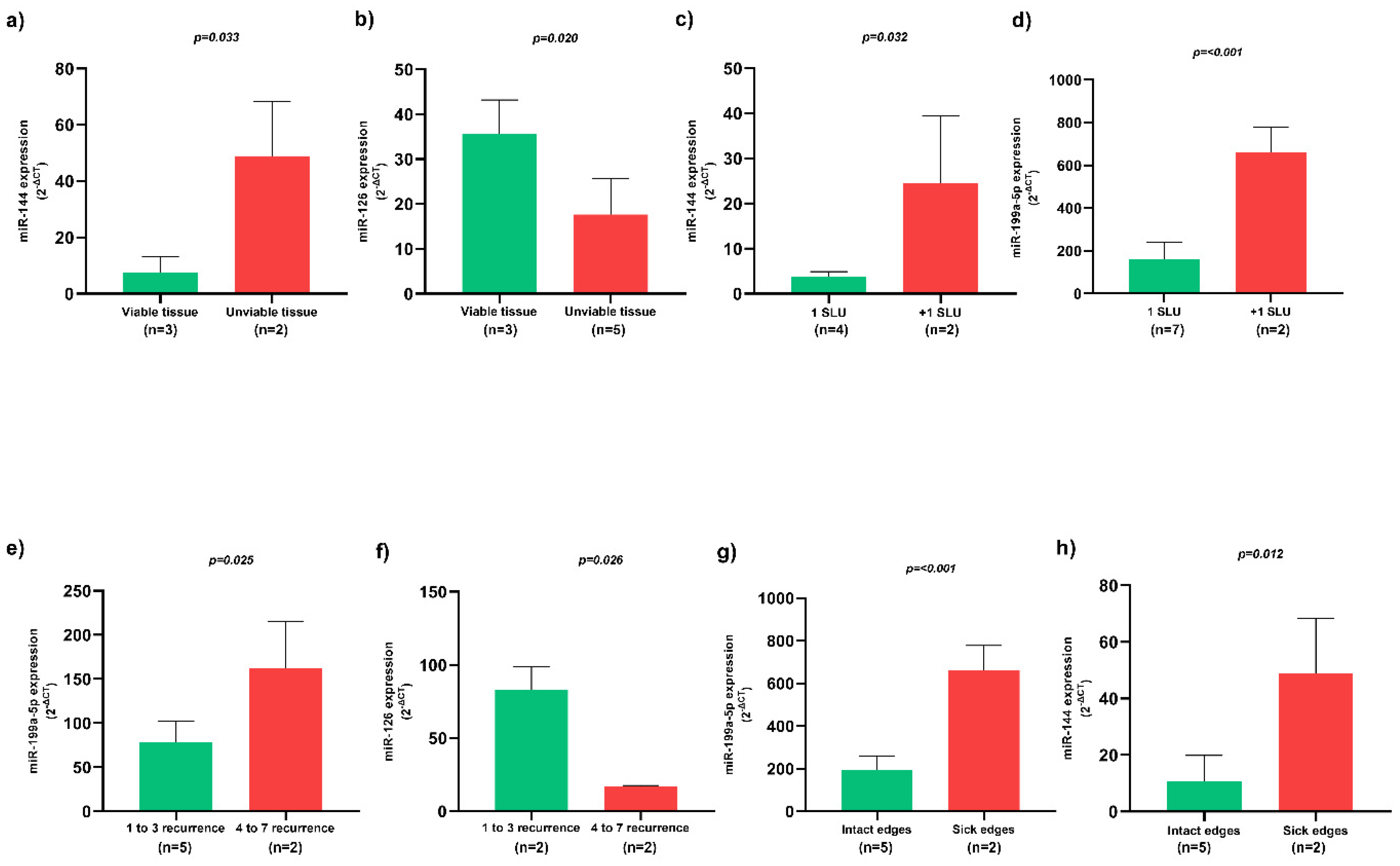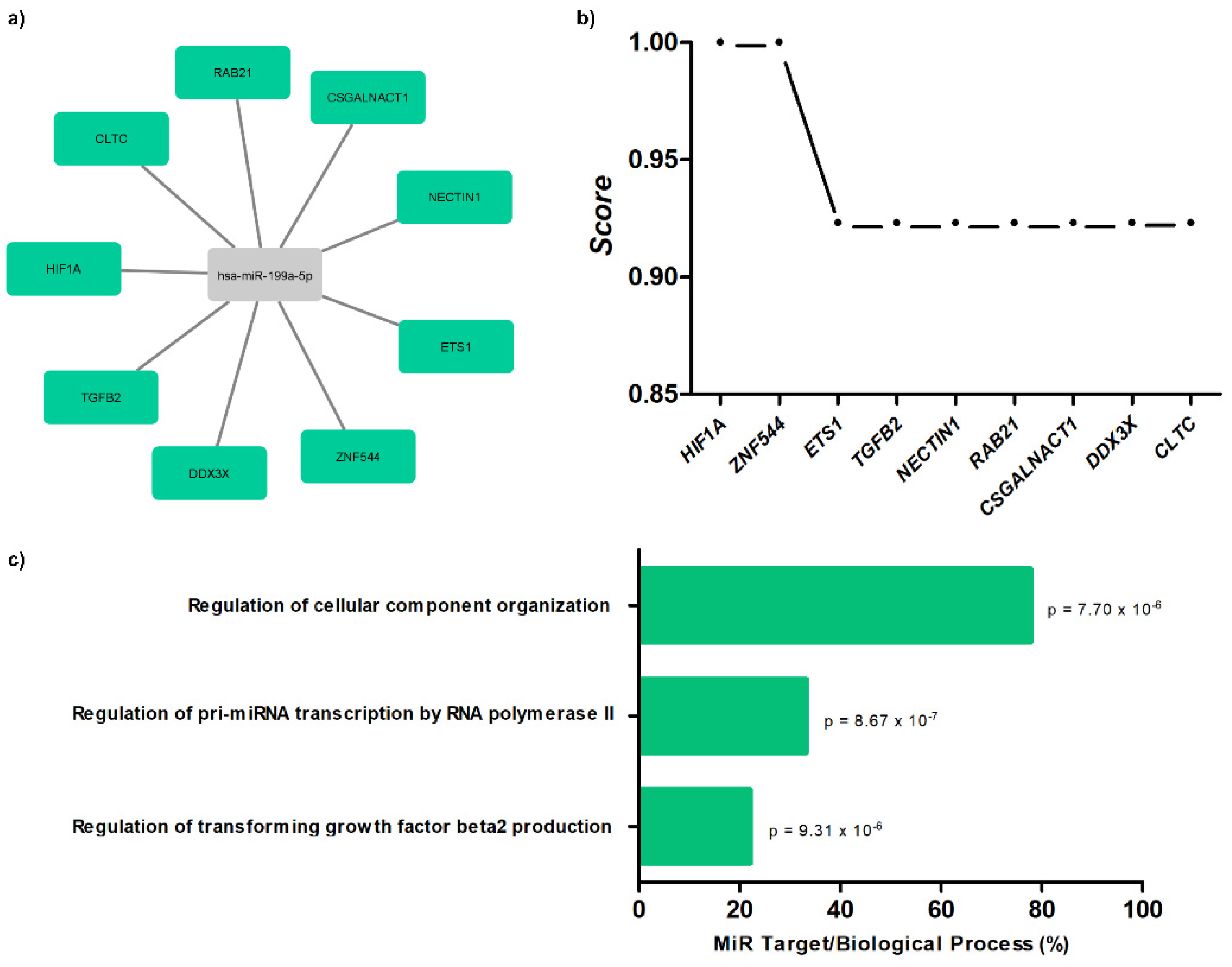A Description of the Hemolytic Component in Sickle Leg Ulcer: The Role of Circulating miR-199a-5p, miR-144, and miR-126
Abstract
:1. Introduction
2. Materials and Methods
2.1. Study Design
2.2. Clinical Characteristics of SLU
2.3. Laboratory Biomarkers
2.4. miRNA Analyses
2.5. Statistical Analyses
3. Results
3.1. Characteristics of the Investigated Population
3.2. Circulating miRNAs Expression in SCD Patients and between HbSS and HbSC Genotype with and without SLU
3.3. Correlation Coefficients between Hemolytic Biomarkers and Circulating miRNAs Expression in SLU+ Patients
3.4. Circulating miRNAs Expression in Active SLU
3.5. Association of HU with Circulating miRNAs Expression in Patients with and without SLU
3.6. Target Gene Prediction with Biological Processes of miR-199a-5p to SCD Patients
4. Discussion
Supplementary Materials
Author Contributions
Funding
Institutional Review Board Statement
Informed Consent Statement
Data Availability Statement
Acknowledgments
Conflicts of Interest
References
- Njoku, F.; Zhang, X.; Shah, B.N.; Machado, R.F.; Han, J.; Saraf, S.L.; Gordeuk, V.R. Biomarkers of clinical severity in treated and untreated sickle cell disease: A comparison by genotypes of a single center cohort and African Americans in the NHANES study. Br. J. Haematol. 2021, 194, 767–778. [Google Scholar] [CrossRef] [PubMed]
- Antwi-Boasiako, C.; Andemariam, B.; Colombatti, R.; Asare, E.V.; Strunk, C.; Piccone, C.M.; Manwani, D.; Boruchov, D.; Farooq, F.; Urbonya, R.; et al. A study of the geographic distribution and associated risk factors of leg ulcers within an international cohort of sickle cell disease patients: The CASiRe group analysis. Ann. Hematol. 2020, 99, 2073–2079. [Google Scholar] [CrossRef] [PubMed]
- Sickle Cell Disease: Ulcers: Prevention and Treatment, 1st ed.; Ministério da Saúde. Secretaria de Atenção à Saúde. Departamento de Atenção Especializada: Brasília-DF, Brasil, 2012; ISBN 978-85-334-1957-5.
- Senet, P.; Blas-Chatelain, C.; Levy, P.; Manea, E.M.; Peschanski, M.; Mirault, T.; Stankovic-Stojanovic, K.; Debure, C.; Debbache, K.; Girot, R.; et al. Factors predictive of leg-ulcer healing in sickle cell disease: A multicentre, prospective cohort study. Br. J. Dermatol. 2017, 177, 206–211. [Google Scholar] [CrossRef]
- Umeh, N.I.; Ajegba, B.; Buscetta, A.J.; Abdallah, K.E.; Minniti, C.P.; Bonham, V.L. The psychosocial impact of leg ulcers in patients with sickle cell disease: I don’t want them to know my little secret. PLoS ONE 2017, 12, e0186270. [Google Scholar] [CrossRef] [Green Version]
- Li, B.; Zhu, X.; Ward, C.M.; Starlard-Davenport, A.; Takezaki, M.; Berry, A.; Ward, A.; Wilder, C.; Neunert, C.; Kutlar, A.; et al. MIR-144-mediated NRF2 gene silencing inhibits fetal hemoglobin expression in sickle cell disease. Exp. Hematol. 2019, 70, 85–96. [Google Scholar] [CrossRef]
- Yang, X.; Zheng, Y.; Tan, J.; Tian, R.; Shen, P.; Cai, W.; Liao, H. miR-199a-5p–HIF-1α-STAT3 positive feedback loop contributes to the progression of non-small cell lung cancer. Front. Cell Dev. Biol. 2021, 8, 1–13. [Google Scholar] [CrossRef]
- Le, N.-T.; Abe, J. MicroRNA 199a and the eNOS (Endothelial NO Synthase)/NO Pathway. Arterioscler. Thromb. Vasc. Biol. 2018, 38, 2278–2280. [Google Scholar] [CrossRef] [Green Version]
- Pan, Q.; Zheng, J.; Du, D.; Liao, X.; Ma, C.; Yang, Y.; Chen, Y.; Zhong, W.; Ma, X. microRNA-126 priming enhances functions of endothelial progenitor cells under physiological and hypoxic conditions and their therapeutic efficacy in cerebral ischemic damage. Stem Cells Int. 2018, 2018, 1–13. [Google Scholar] [CrossRef]
- Bryan, N.S.; Grisham, M.B. Methods to detect nitric oxide and its metabolites in biological samples. Free Radic. Biol. Med. 2007, 43, 645–657. [Google Scholar] [CrossRef] [Green Version]
- Nascimento, J.S.; de Goes, T.C.; Lima, P.S.P.; Sousa, S.M.B.; Kaneto, C.M. Mir-342-3p as an internal control for the normalization in miRNA quantification from hypertensive patients with left ventricular hypertrophy. Braz. J. Dev. 2021, 7, 23134–23152. [Google Scholar] [CrossRef]
- Prado, M.S.J.G.; de Goes, T.C.; de Jesus, M.L.; Mendonça, L.S.O.; Nascimento, J.S.; Kaneto, C.M. Identification of miR-328-3p as an endogenous reference gene for the normalization of miRNA expression data from patients with Diabetic Retinopathy. Sci. Rep. 2019, 9, 19677. [Google Scholar] [CrossRef] [Green Version]
- Theocharidou, E.; Suddle, A.R. The liver in sickle cell disease. Clin. Liver Dis. 2019, 23, 177–189. [Google Scholar] [CrossRef] [PubMed]
- Minniti, C.P.; Taylor, J.G.; Hildesheim, M.; O’Neal, P.; Wilson, J.; Castro, O.; Gordeuk, V.R.; Kato, G.J. Laboratory and echocardiography markers in sickle cell patients with leg ulcers. Am. J. Hematol. 2011, 86, 705–708. [Google Scholar] [CrossRef] [PubMed]
- Joris, V.; Gomez, E.L.; Menchi, L.; Lobysheva, I.; Di Mauro, V.; Esfahani, H.; Condorelli, G.; Balligand, J.-L.; Catalucci, D.; Dessy, C. microRNA-199a-3p and microRNA-199a-5p take part to a redundant network of regulation of the NOS (NO synthase)/NO pathway in the endothelium. Arterioscler. Thromb. Vasc. Biol. 2018, 38, 2345–2357. [Google Scholar] [CrossRef] [Green Version]
- Yang, H.H.; Chen, Y.; Gao, C.Y.; Cui, Z.T.; Yao, J.M. Protective effects of microRNA-126 on human cardiac microvascular endothelial cells against hypoxia/reoxygenation-induced injury and inflammatory response by activating PI3K/AKT/eNOS signaling pathway. Cell. Physiol. Biochem. 2017, 42, 506–518. [Google Scholar] [CrossRef] [PubMed]
- Pedrosa, A.M.; Lemes, R.P.G. Gene expression of HIF-1α and VEGF in response to hypoxia in sickle cell anaemia: Influence of hydroxycarbamide. Br. J. Haematol. 2020, 190, e39–e42. [Google Scholar] [CrossRef] [PubMed]
- Switzer, C.H.; Cheng, R.Y.S.; Ridnour, L.A.; Glynn, S.A.; Ambs, S.; Wink, D.A. Ets-1 is a transcriptional mediator of oncogenic nitric oxide signaling in estrogen receptor-negative breast cancer. Breast Cancer Res. 2012, 14, 1–13. [Google Scholar] [CrossRef] [PubMed] [Green Version]
- Miscianinov, V.; Martello, A.; Rose, L.; Parish, E.; Cathcart, B.; Mitić, T.; Gray, G.A.; Meloni, M.; Al Haj Zen, A.; Caporali, A. microRNA-148b targets the TGF-β pathway to regulate angiogenesis and endothelial-to-mesenchymal transition during skin wound healing. Mol. Ther. 2018, 26, 1996–2007. [Google Scholar] [CrossRef] [Green Version]
- Wang, J.; Yao, Y.; Wang, K.; Li, J.; Chu, T.; Shen, H. MicroRNA-148a-3p alleviates high glucose-induced diabetic retinopathy by targeting TGFB2 and FGF2. Acta Diabetol. 2020, 57, 1435–1443. [Google Scholar] [CrossRef] [PubMed]
- Wang, Y.; Dai, Y.-X.; Wang, S.-Q.; Qiu, M.-K.; Quan, Z.-W.; Liu, Y.-B.; Ou, J.-M. miR-199a-5p inhibits proliferation and induces apoptosis in hemangioma cells through targeting HIF1A. Int. J. Immunopathol. Pharmacol. 2018, 31, 1–10. [Google Scholar] [CrossRef] [Green Version]
- Li, W.; Wang, H.; Zhang, J.; Zhai, L.; Chen, W.; Zhao, C. miR-199a-5p regulates β1 integrin through Ets-1 to suppress invasion in breast cancer. Cancer Sci. 2016, 107, 916–923. [Google Scholar] [CrossRef] [PubMed] [Green Version]
- Antwi-Boasiako, C.; Campbell, A.D. Low nitric oxide level is implicated in sickle cell disease and its complications in Ghana. Vasc. Health Risk Manag. 2018, 14, 199–204. [Google Scholar] [CrossRef] [PubMed] [Green Version]




| Independent Variables | Dependent Variable | p-Value | β | R2 | p-Value of the Model | |
|---|---|---|---|---|---|---|
| SLU- patients N = 43 | Circulating miR-199a-5p | Hydroxyurea | 0.007 | 0.695 | 0.486 | 0.022 |
| Circulating miR-144 | 0.096 | 0.468 | ||||
| Circulating miR-126 | 0.009 | −0.834 | ||||
| SLU+ patients N = 15 | Circulating miR-199a-5p | 0.485 | 0.191 | 0.779 | 0.043 | |
| Circulating miR-144 | 0.997 | −0.001 | ||||
| Circulating miR-126 | 0.011 | −0.885 |
Publisher’s Note: MDPI stays neutral with regard to jurisdictional claims in published maps and institutional affiliations. |
© 2022 by the authors. Licensee MDPI, Basel, Switzerland. This article is an open access article distributed under the terms and conditions of the Creative Commons Attribution (CC BY) license (https://creativecommons.org/licenses/by/4.0/).
Share and Cite
Santos, E.d.C.; Melo, G.I.V.; Santana, P.V.B.; Quadros, I.G.S.; Yahouédéhou, S.C.M.A.; Guarda, C.C.d.; Santiago, R.P.; Fiuza, L.M.; Carvalho, S.P.; Adorno, E.V.; et al. A Description of the Hemolytic Component in Sickle Leg Ulcer: The Role of Circulating miR-199a-5p, miR-144, and miR-126. Biomolecules 2022, 12, 317. https://doi.org/10.3390/biom12020317
Santos EdC, Melo GIV, Santana PVB, Quadros IGS, Yahouédéhou SCMA, Guarda CCd, Santiago RP, Fiuza LM, Carvalho SP, Adorno EV, et al. A Description of the Hemolytic Component in Sickle Leg Ulcer: The Role of Circulating miR-199a-5p, miR-144, and miR-126. Biomolecules. 2022; 12(2):317. https://doi.org/10.3390/biom12020317
Chicago/Turabian StyleSantos, Edvan do Carmo, Gabriela Imbassahy Valentim Melo, Paulo Vinícius Bispo Santana, Idaiara Graziele Silva Quadros, Sètondji Cocou Modeste Alexandre Yahouédéhou, Caroline Conceição da Guarda, Rayra Pereira Santiago, Luciana Magalhães Fiuza, Suéllen Pinheiro Carvalho, Elisângela Vitória Adorno, and et al. 2022. "A Description of the Hemolytic Component in Sickle Leg Ulcer: The Role of Circulating miR-199a-5p, miR-144, and miR-126" Biomolecules 12, no. 2: 317. https://doi.org/10.3390/biom12020317
APA StyleSantos, E. d. C., Melo, G. I. V., Santana, P. V. B., Quadros, I. G. S., Yahouédéhou, S. C. M. A., Guarda, C. C. d., Santiago, R. P., Fiuza, L. M., Carvalho, S. P., Adorno, E. V., Kaneto, C. M., Fonseca, T. C. C., Goncalves, M. S., & Aleluia, M. M. (2022). A Description of the Hemolytic Component in Sickle Leg Ulcer: The Role of Circulating miR-199a-5p, miR-144, and miR-126. Biomolecules, 12(2), 317. https://doi.org/10.3390/biom12020317






